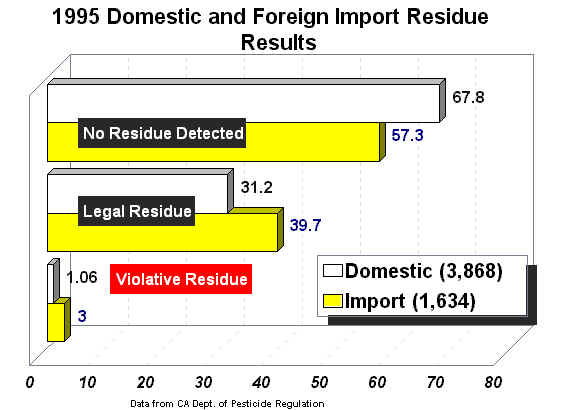
COOPERATIVE EXTENSION
UNIVERSITY OF CALIFORNIA
ENVIRONMENTAL TOXICOLOGY NEWSLETTER
"Published Occasionally at Irregular Intervals"
Vol. 17 No. 4, DECEMBER 1997
In This Issue
Introduction
In the last newsletter of this year, we present three pieces of information. The first comes from the Department of Pesticide Regulation (DPR) and contains the results of the 1995 residue monitoring programs. The second also comes from DPR and contains toxicology review summaries available electronically. The third is composed of excerpts and sum-maries derived from a report which recently appeared in the journal Cancer 80:2019-33, 1997 titled: "Report of a Panel on the Relationship between Public Exposure to Pesticides and Cancer." This report was produced by a Canadian panel of experts. I found this review to be well done and interesting. The complete paper contains much more information on topics considered by the Panel, and expands on their recommendations. The primary purpose of the review as I understand it, was to review their national priorities for cancer control. Their conclusions were not unexpected, and did support the view that the majority of cancers are caused by smoking and diet, two environmental factors which are composed of incredibly complex mixtures of chemicals.
While this report will certainly not put the issue to rest, I think it helps to put it into perspective (again), something which must be done over and over again. I wholeheartedly support their recom-mendation that we review this issue as new data become available. Each year we see new reports on the measurement of pesticide residues in foods. If you look at the historical data in California, it is clear that the picture is not changing. Some groups take the national data on residues and rework it to make it appear that some foods are unsafe, or less safe than others, based only on the residue data. What is really needed before this issue is revisited are new toxicological and epidemiological data, particularly data which can link exposure to measurable biological endpoints.
"From the personnel of Environmental Toxicology Extension, we wish you all a happy holiday season." During this holiday season, many of us tend to overindulge a bit in our chemical intake, sometimes resulting in a positive nutritional balance and subsequent increase in body mass. This then leads to a seasonal (and usually short-term) revision of our chemical intake in order to reduce our body mass to the size which will fit comfortably into the chemical fabrics we wear. We can help you avoid this unpleasantness. Just send your holiday cakes, cookies and intoxicating beverages to us for hazardous chemical disposal. We won’t tell you how, but we will take care of it!
Stay tuned for more issues next year!
California Department of Pesticide Regulation (DPR) Residue Testing Results, 1995
The following graphs present the residue monitoring results from 1995 as presented by DPR in the report titled "Residues In Fresh Produce--1995 Monitoring Program." Once again, the results are virtually the same as last year, indicating excellent quality control in the use of pesticides on crops in California. The percentage of "No residue detected" or "Residue at 0-10% of tolerance" continues to hover at the 90% level for commercially grown produce.
This year, there was no information on tested "organic" produce, which prompted us to call DPR to ask about it. We were informed that DPR no longer flags "organic" produce samples, and their results are included in the results of all produce samples.
Copies of these graphs and tables are available as slides for any UCCE personnel who wish copies. Next year, I expect that similar results will be available for 1996.


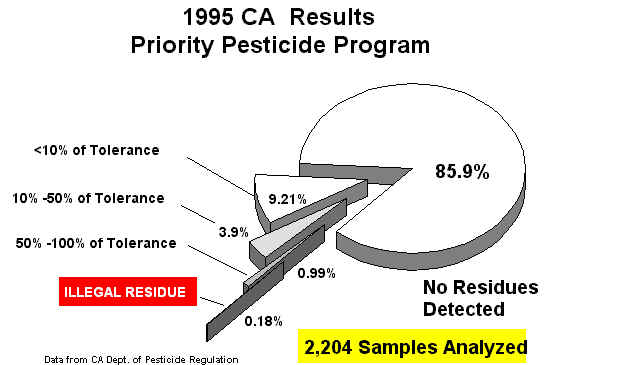
The DPR toxicology data reviews are distributed freely on the Internet via DPR's Home Page: http://www.cdpr.ca.gov. In order to read the electronic reviews in PDF format, requestors must install Adobe© Acrobat Reader. This program can also be downloaded from DPR's Home Page. Some of the files can be downloaded into WordPerfect© 6.1. Also, the data reviews will be periodically updated.
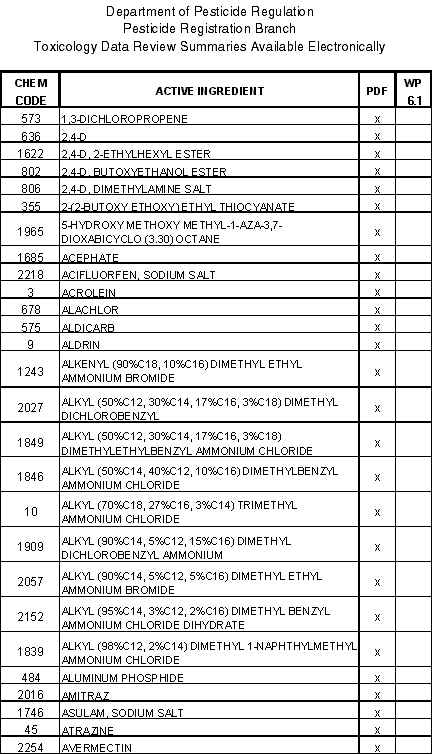
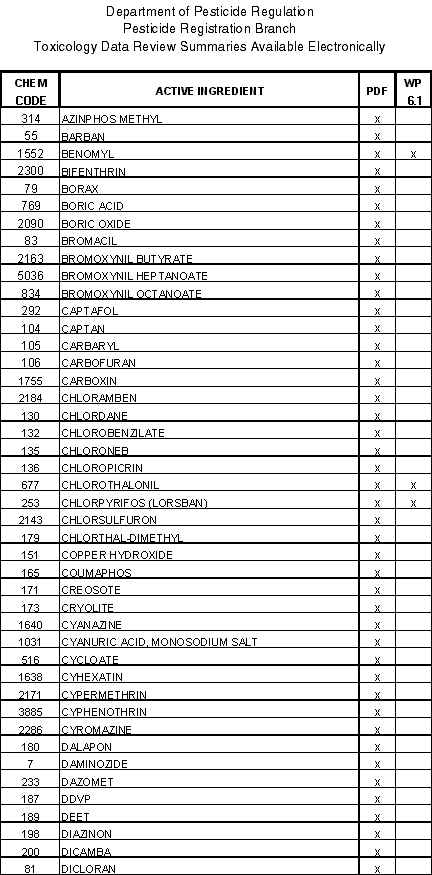
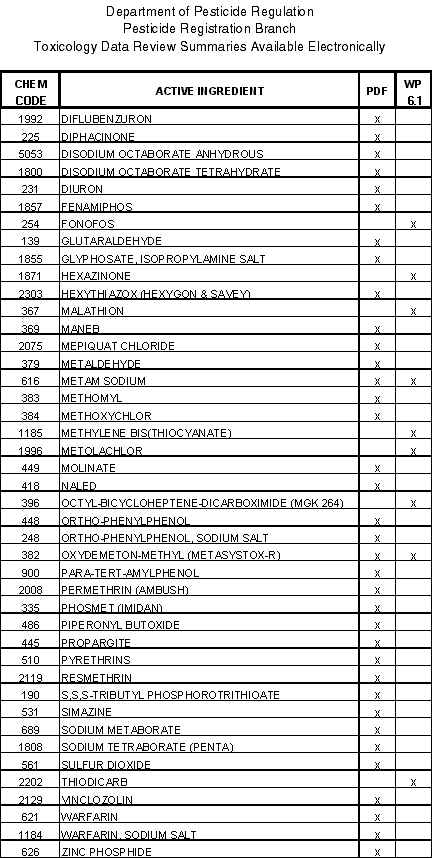
Report of a Panel on the Relationship between Public Exposure to Pesticides and Cancer
The following is based on information taken directly form the report published in Cancer. The most important elements of this report are covered in the conclusions as stated in the abstract.
"The Panel concluded that it was not aware of any definitive evidence to suggest that synthetic pesticides contribute significantly to overall cancer mortality. The Panel . . . did not believe that any increased intake of pesticide residues associated with increased intake of fruits and vegetables poses any increased cancer risk. The Panel further concluded . . . tobacco use continues to be the most important preventable cause of cancer and premature mortality and thus is an appropriate focus for cancer control strategy."
The report contains a very well written and concise review of many studies which relate to pesticide toxicology and human effects. During the review of data, the panel also stressed and took into consideration potential sensitive populations, especially infants and children.
A brief summary of their conclusions and recommendations is included, and perhaps the most important point which was stressed by the Panel is the fact that this is a dynamic issue, which must be continuously reevaluated on the basis of new information as it becomes available.
There were 14 listed conclusions in the study, which are summarized below:
1. There are no new data which suggest that the 1981 assessment which stated that synthetic chemicals are responsible for only a very small percentage of cancers (2%) should be changed, however more research is needed to help understand the issue of complex, multiple-chemical exposures.
2. Published evidence is suggestive that phenoxy herbicides may be associated with Non-Hodgkins Lymphoma after high occupational exposures, however there is no evidence of risk for the general population, however there have been no studies specifically designed to measure such exposure to herbicides.
3. The Panel supports further studies to explore any links between organo-chlorines and breast cancer.
4. Tobacco use causes 30% of all cancers (as well as other adverse health effects) in Canada and is the most important preventable cause of cancer.
5. Diets rich in fruits and vegetables are important in reducing cancer incidence at multiple sites.
6. Any increase in risk from increased pesticide residue consumption on fruits and vegetables is far outweighed by the protective benefits of increased consumption.
7. Use of pesticides to decrease food costs and increase food quality, thereby promoting increased consumption of fruits and vegetables is recognized as important in reducing cancer risks.
8. The Panel found no evidence that home lawn and garden use of pesticides are likely to be major causes of cancer.
9. Public exposure to pesticide residues is minimal and well below those levels deemed safe by regulatory agencies.
10. The Panel supported the re-review of older pesticides to insure that adequate and new data are considered.
11. The Panel recognizes that there are few data available regarding pesticide exposure and cancer other than the phenoxy herbicides and supports further research.
12. This issue must be revisited and reviewed and amended as newer data become available.
13. There was no evidence found to support changing the focus on elimination of tobacco use as the most appropriate cancer control strategy.
14. Improving risk communication with the public is encouraged.
Happy Holidays from all of the Extension Toxicology Staff:
Art Craigmill
Sandy Ogletree
Scott Wetzlich
Duvall Warren
Ian Taylor
Mike Stimmann
Christine Joshel
Tim Arndt
Loreen Kleinschmidt
Mike Payne
Martha Rangel-Lugo